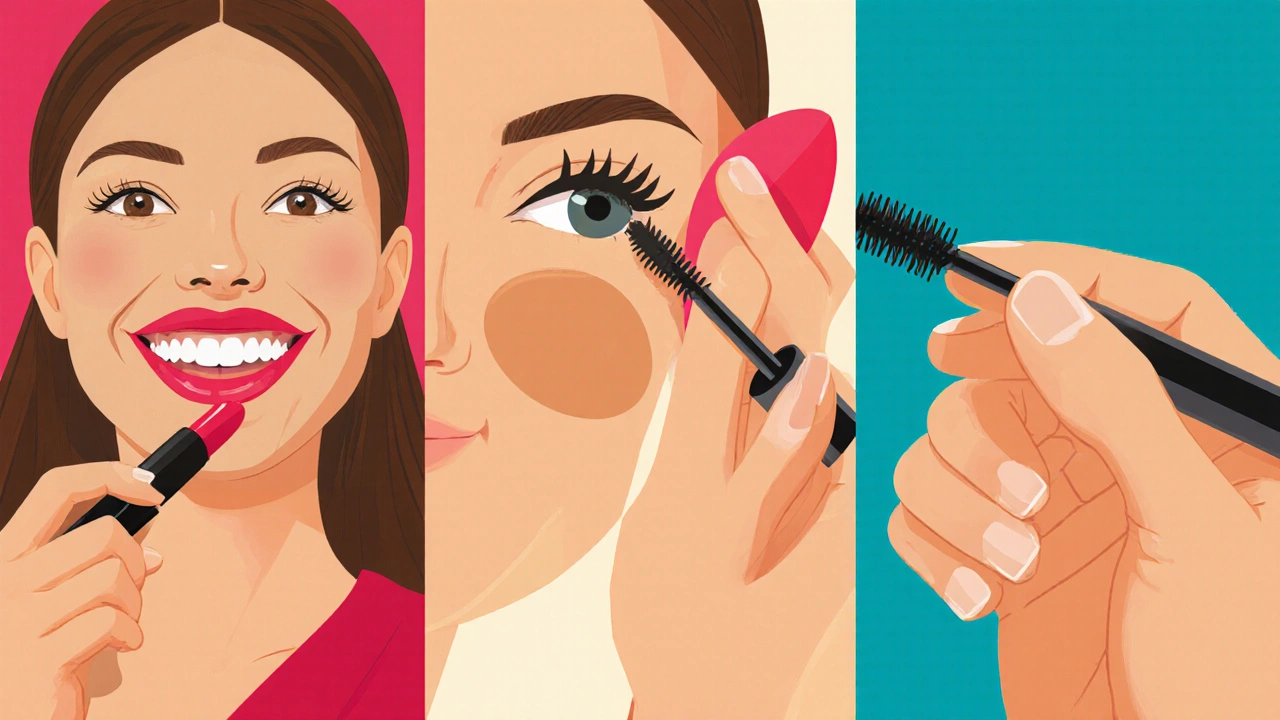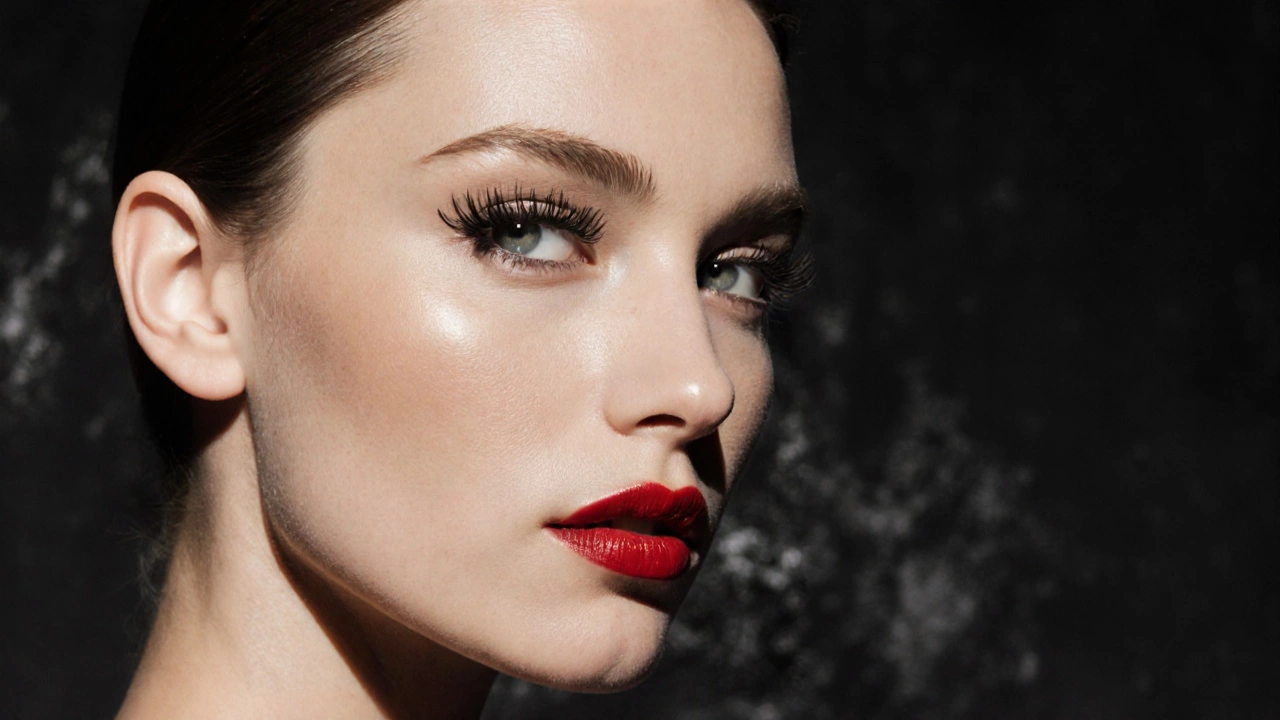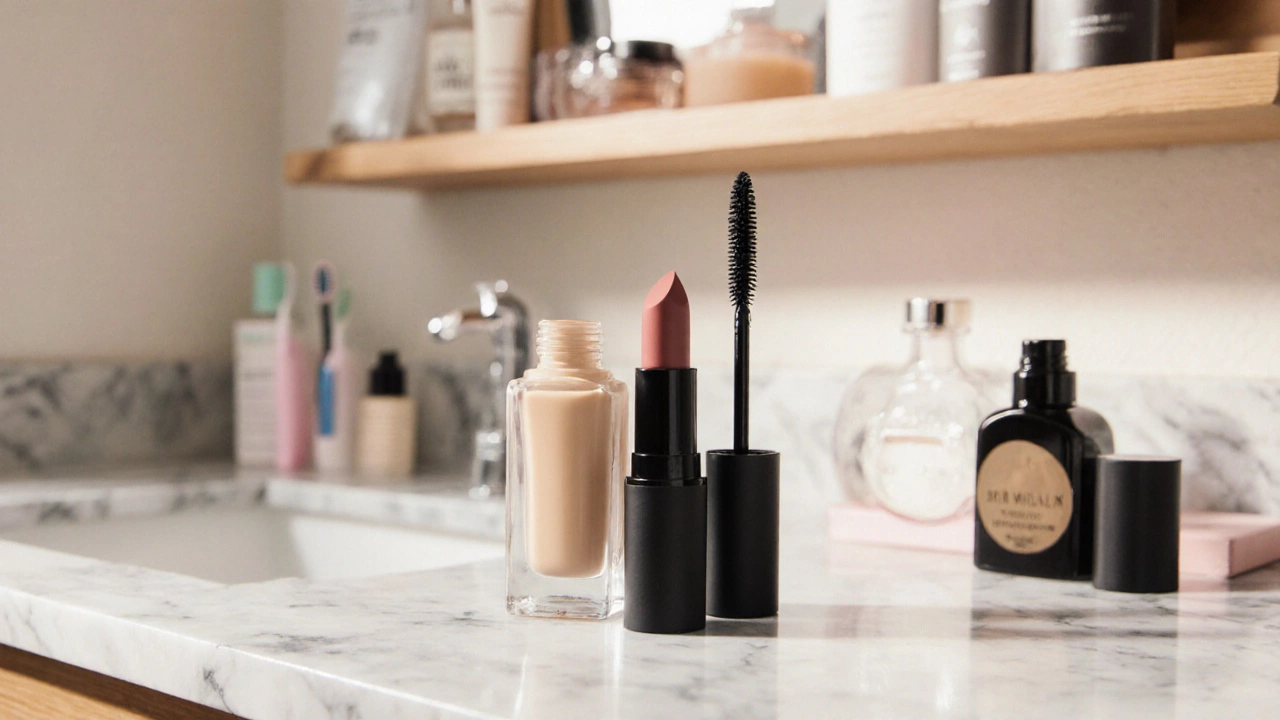Cosmetic Product Selector
Select a cosmetic product below to learn more about its purpose, ingredients, and usage tips.
Lipstick
Adds color and shine to lips
Foundation
Even skin tone and create a base
Mascara
Lengthen, thicken, and darken lashes
Quick Comparison Table
| Product | Primary Purpose | Typical Price Range | Key Ingredients |
|---|---|---|---|
| Lipstick | Add color and shine to lips | $8 – $45 | Waxes, oils, pigments, vitamin E |
| Foundation | Even skin tone, create a base | $12 – $60 | Silicones, pigments, hydrators, SPF |
| Mascara | Lengthen, thicken, darken lashes | $7 – $35 | Film-formers, waxes, pigments |
Ever stared at the bathroom shelf and wondered which products actually count as cosmetics? Let’s clear that up and give you three solid examples you can spot in any makeup bag.
Key Takeaways
- Cosmetics are products that change or enhance appearance, not just skin health.
- The three staple examples are lipstick, foundation, and mascara.
- Each product has a specific purpose, typical price range, and key ingredients you can check on the label.
- Choosing the right one depends on skin type, desired look, and any sensitivities.
What Exactly Are Cosmetics?
When we talk about Cosmetics is a category of products designed to enhance, beautify, or alter the outward appearance of a person. This definition covers everything from color‑changing lipsticks to skin‑smoothing foundations, but it does not include products whose primary goal is therapeutic, like prescription‑only acne medication.
Cosmetics are regulated in many countries as “cosmetic products,” meaning they must be safe when used as intended, but they aren’t required to prove efficacy the way drugs do. Understanding the line between cosmetics and skincare helps you pick the right item for the look you want.

Three Everyday Cosmetic Staples
1. Lipstick
Lipstick is a colorful waxy product applied to the lips to add hue, shine, and sometimes hydration. It comes in matte, satin, gloss, and sheer finishes. The base typically blends pigments, waxes, oils, and emollients. Common ingredients include carnauba wax, jojoba oil, and vitaminE.
How to use it:
- Exfoliate lips with a gentle scrub or a soft toothbrush.
- Apply a thin layer of lip balm for moisture.
- Line the lips with a matching lip liner (optional for precision).
- Swipe on lipstick, starting at the center and moving outward.
- Blot with a tissue and re‑apply for longer wear.
2. Foundation
Foundation is a liquid, cream, or powder that evens out skin tone and creates a uniform base for other makeup. It can be oil‑based, water‑based, or hybrid, and it usually contains pigments, silicones, and moisturizing agents. Look for ingredients like hyaluronic acid for hydration or silica for a matte finish.
Application steps:
- Start with clean, moisturized skin.
- Choose a shade that matches your jawline or the “test on wrist” method.
- Dispense a pea‑size amount onto the back of your hand.
- Use a damp beauty sponge or brush to blend outward in light, tapping motions.
- Set with translucent powder if you have oily skin.
3. Mascara
Mascara is a pigmented coating applied to eyelashes to lengthen, thicken, and darken them. It typically contains water, film‑forming polymers, and waxes. Look for waterproof formulas if you expect humidity or tears.
To get the best lift:
- Curl lashes with a heated or traditional curler.
- Wiggle the wand at the base of the lashes, then sweep upward.
- Apply a second coat while the first is still slightly damp for added volume.
- Use a fine‑tip brush to separate any clumps.
Beyond the Basics: Other Common Cosmetics
While lipstick, foundation, and mascara cover the majority of daily looks, there are a few other products worth knowing.
- Moisturizer is a hydrating cream or lotion that prepares the skin for makeup. Even though it’s often marketed as skincare, many moisturizers are classified as cosmetics when they contain tint or SPF.
- Sunscreen is a protective lotion that filters UV radiation. Some tinted sunscreens double as light foundations.
- Perfume is a fragrant blend applied to pulse points for scent. Though not visual, it’s legally a cosmetic.
- Eyeliner is a pencil, gel, or liquid used to define the eyes.
- Blush is a powder or cream that adds color to the cheeks.
Choosing the Right Cosmetic for Your Needs
Not every product works for every person. Here’s a quick checklist to help you decide:
- Skin type: Oily skin often prefers matte foundations and oil‑free mascaras, while dry skin benefits from hydrating lipstick formulas.
- Desired finish: Do you want a natural glow or full‑glam? Choose satin or gloss lipstick for shine, matte foundation for a flawless finish.
- Allergies: Scan ingredient lists for common irritants like parabens, fragrance, or lanolin.
- Budget: Drugstore brands can perform just as well as prestige lines if you match the formula to your skin.
- Longevity: Waterproof mascara and long‑wear lipstick are worth the extra cost for all‑day events.

Ingredient Basics to Watch
Understanding a few key ingredients helps you avoid surprises.
- Silicones (e.g., dimethicone): Provide smooth texture, great for foundation but can feel heavy on very oily skin.
- Waxes (beeswax, candelilla): Give lipstick its shape; natural waxes tend to be less irritating.
- Film‑formers (acrylate copolymers): Keep mascara from flaking.
- Preservatives (phenoxyethanol, parabens): Extend shelf life; some people prefer preservative‑free formulas.
- Sun filters (zinc oxide, avobenzone): If your foundation includes SPF, you’re getting two‑in‑one protection.
Quick Comparison of the Three Core Cosmetics
| Product | Primary Purpose | Typical Price Range (USD) | Key Ingredients | Best For |
|---|---|---|---|---|
| Lipstick | Add color and shine to lips | $8 - $45 | Waxes, oils, pigments, vitaminE | Quick color pop, long‑wear events |
| Foundation | Even skin tone, create a base | $12 - $60 | Silicones, pigments, hydrators, SPF | Full‑coverage looks, photo shoots |
| Mascara | Lengthen, thicken, darken lashes | $7 - $35 | Film‑formers, waxes, pigments | Eye‑opening effect, everyday wear |
Frequently Asked Questions
Are lipstick, foundation, and mascara all considered cosmetics?
Yes. All three are classified as cosmetics because they are applied to the body primarily to enhance appearance. They don’t require a prescription and are regulated under cosmetic‑product guidelines.
Can I use a foundation that contains SPF as my daily sunscreen?
Foundation with SPF offers some protection, but it usually doesn’t meet the broad‑spectrum coverage needed for full sun safety. Pair it with a dedicated moisturizer‑sunscreen for optimal defense.
What’s the difference between waterproof and water‑resistant mascara?
Water‑resistant mascara may smudge with heavy sweating or tears, while waterproof formulas use stronger film‑forming polymers that stay intact even in humid conditions or after swimming.
I have sensitive skin. Which of the three core cosmetics should I avoid?
Check for fragrance, parabens, and certain dyes. Many sensitive‑skin foundations are labeled "non‑comedogenic" and "hypoallergenic." Lipsticks with fewer pigments and moisturizers with soothing ingredients like aloe are safer bets.
How often should I replace my mascara?
Most experts recommend discarding mascara after three to six months. Bacterial buildup can cause eye infections, especially if the product is exposed to moisture.
There you have it-three clear cosmetics examples you can spot, how they work, and what to look for when you pick one. Armed with this knowledge, you’ll feel confident reaching for the right product without second‑guessing whether it truly counts as a cosmetic.

